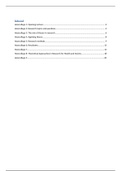Inhoud
Hoorcollege 1: Opening Lecture.............................................................................................................2
Hoorcollege 2: Research topics and questions.......................................................................................3
Hoorcollege 3: The role of theory in research........................................................................................6
Hoorcollege 4: Applying theory..............................................................................................................8
Hoorcollege 5: Research methods..........................................................................................................9
Hoorcollege 6: Resultaten....................................................................................................................13
Hoorcollege 7.......................................................................................................................................14
Hoorcollege 8: Theoretical Approaches in Research for Health and Society........................................18
Hoorcollege 9.......................................................................................................................................20
,Hoorcollege 1: Opening Lecture
Video
- Several ways of interpretations of results
- Important to base conclusion on more than one study
Systematic Review
- How often it happens
- Causes
- Relationships
- Define a certain concept
- Based on qualitative studies how people experience something
Need for Systematic Reviews
- Amount of information has increased
Value of Systematic Reviews
Need why are they done
Value what do the studies contribute to
- To support policy: to those who form policies
- To support practice: for people who support patients with e.g. dementia; how to activate students;
how to teach children multiple languages and how to implement that
- To guide future research: knowledge gaps, overview what is already been done and what is still
missing
Types of Reviews
- Voordeel: leest makkelijk, inhoudsopgave e.d.
- Nadelen: selection bias, niet duidelijk hoe artikelen zijn geselecteerd daardoor niet te repliceren
Systematic literature Review
- ‘Cookbook method’ everyone can follow the same recipe because the instructions are there
- Better quality
- Depends on type of articles that you include
Meta-analysis
- Systematic review, but now only quantitative data (regression, effect size, etc.) requires very
specific criteria
- Always some degree of bias, but can be reduced the more systematic it is done
Types of Reviews
‘He fed her cat food’ he gave her cat food, or he fed her cat
People involved in analysis, interpretation, so always depends on the people and how they interpret
all data
, Difference between systematic and meta systematic collects both quantitative and qualitative
data (more story like section); meta only data about effects (quantitative), so not how it works. More
results with numbers
All studies can be included in systematic review
Only quantitative data can be used for meta analyses
Cycle
- identify gap
- identify suitable theory to structure, gather the data
- method how to apply your criteria, how to search for information
- results (ass. 3) what tools available to assess quality of data; how to analyse results, how to
interpret results
Narrowing
- where? in which country
- zorgen dat het voor jezelf duidelijk/afgebakend genoeg is
Important
Thesis doesn’t have to be a systematic review
Knowing uncertainty
- known known facts, medical assumptions. These belong to introduction section. Belong to
previously done studies
- known unknowns things that we know that are missing; knowledge gaps. Belong to the reason
why you conducted research. Problem statement
- unknown unknown things you didn’t know that you didn’t know, discovered based on results of
studies. Lead to suggestions for new research.
Hoorcollege 2: Research topics and questions
Alles wat in college behandeld wordt kan examenstof zijn
What, How, Why
Why – relevance
The components of a problem statement
1. Anecdote, statistics, title of research, something that catches the attention of the reader. Also
describe the context: magnitude, impact, why is it a problem (indication, consequences). Come
across credible, provide background information.
2. Is it original? Are you contributing to something new, adding to science/practice? What is the
knowledge gap
3. Focus/aim of your study, what are you trying to give an answer to
4. What is significance of your research
- practical relevance after done this study, what can policy makers or practice do with the gained
knowledge, what can you do with insights in practice
- scientific relevance






